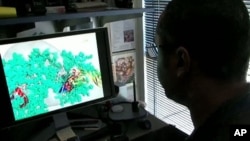In May of 1997, U.S. President Bill Clinton set the goal of developing a vaccine against HIV, the virus that causes AIDS, within 10 years. The Vaccine Research Center at the National Institute of Health was established to help achieve the ambitious goal. That decade has come and gone with no HIV vaccine. But, scientists are tirelessly pressing forward and have made some promising discoveries.
Like many medical practitioners specializing in HIV/AIDS treatment, Dr. Raymond Martins with the Whitman Walker Clinic in Washington is frustrated by the lack of progress toward an HIV vaccine.
The United Nations says more than 30 million people worldwide are living with HIV. Powerful drugs can now limit the damage the virus can do to the human immune system. But neutralizing or preventive vaccines remains elusive.
“HIV mutates quickly and it is also highly variable in the protein that it expresses on its coat, so because of that, it makes it very difficult to form an effective vaccine,” Dr. Martins said.
Dr. Gary Nabel, has been director of the Vaccine Research Center at the National Institutes of Health, since its founding 12 years ago. He, too, sees the AIDS virus as a tough adversary, with unique features that make vaccine development difficult.
“One is that it is moving, genetically," he said. "And what I mean by that is that every time the virus divides, the genetic makeup of the virus changes and you end up with different forms of the virus. So, it is constantly mutating. And what that means is that it gives it more chance to escape from the human antibody [immune system] response.”
Another feature of HIV is that proteins on the surface of the virus are constantly moving, almost like a tree branch swaying back and forth in a stiff wind. The proteins are also coated with sugars that mask their identity. The result is the immune system never has a stationary target to attack.
“And so that movement, that camouflage by sugars, make it very difficult for the immune system to even see the parts of the virus that we would want to target,” Dr. Nable said.
In the past year, the Vaccine Research Center has made a promising discovery. They have successfully targeted a known vulnerability in the virus, a part that never changes, with antibodies taken from HIV-infected humans. More importantly researchers have cloned these antibodies in the laboratory.
“These antibodies that come from HIV-infected individuals can recognize and neutralize over 90 percent of the naturally circulating [HIV] strains," Dr. Nabel said. "That is something that we didn’t know even a year ago. And it really identifies a target for vaccine development that is fixed and is vulnerable and we know humans can recognize and respond too.”
Dr. Nabel cautions that this new approach to an HIV vaccine is in its preliminary stages. Even if all goes well, which is rare, success could be many years away. For now, though, there is a glimmer of hope.
“I would be the last person to tell you that it will be done before it is done," he said. "I think we need to prove it and we need to get things across the finish line. But I do think we are in a fundamentally different situation than we have been in the past.”










